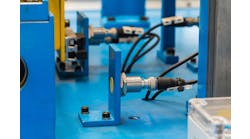Mike Bacidore is the editor in chief for Control Design magazine. He is an award-winning columnist, earning a Gold Regional Award and a Silver National Award from the American Society of Business Publication Editors. Email him at [email protected].
Robots have their hands—er, arms—in more manufacturing and assembly processes than ever. Affordability and ease of integration has helped to increase their popularity, but none of that would be practical without the use of sensors to let the robot’s control system know what to do, based on the environment.
As these two technologies converge, several questions arise, so we posed them to a panel of industry veterans. They include Chris Elston, senior controls engineer, Yamaha Robotics; Scott Mabie, general manager of Americas region, Universal Robots; Helge Hornis, manager intelligent systems group, Pepperl+Fuchs; Victor Caneff, business development manager, assembly and robotics, Banner Engineering; and Balluff marketing managers Wolfgang Kratzenberg, industrial identification, Henry Menke, position sensing, and Shishir Rege, networking.
Chris Elston
Scott Mabie
Helge Hornis
Victor Caneff
Wolfgang Kratzenberg
Henry Menke
Shishir Rege
Presence sensors run the gamut—from capacitive and inductive proximity sensors to ultrasonic and photoelectric sensors, not to mention safety devices. Explain the importance of sensing devices to robotic integration in machines and equipment.
Elston: There are three types of sensor categories that come to my mind that are added in conjunction to an off-the-shelf robot, not including the sensors that are already pre-designed into a robot such as encoder feedback or, in the case of Yamaha Robotics, resolver feedback devices. Basic tooling sensing is end-of-arm tooling (EOAT) sensing. Preventive sensing is for things you don't want to see happen to a robot, like a crash. Safety sensing is to sense humans when they’re close to a robot in motion.
Each of these categories is important to ensure problem-free, maintenance-free and injury-free operation of industrial robots.
EOAT sensing is important in regards that not everything is manufactured perfectly. EOAT, or gripper, sensors are typically proximity or photoelectric type that sense when an object is gripped into the robot tooling, which is wired into the robot's logic process. If the gripper sensor is not active, for example, program structure will instruct the robot to take a different path or maybe stop operations to alert an operator nearby to look and see what the problem is and why the robot does not sense a part in the gripper. This type of sensing is typically twofold, where it's important to sense part presence with a robot to ensure trouble-free operations and it also instills a quality standard when a part entering a work cell is verified and detected by the robot EOAT before the robot attempts to advance the process on the given part. All robots should at a minimum have EOAT sensors as a standard when integrated into a work cell.
Preventive sensing typically is trying to go one step above and beyond basic EOAT sensing. Most of the time, preventive sensing is made up of a type of analog sensor such as a load cell. These are used when a robot picks up a part, but there is a misalignment in the process. The robot doesn't typically have the ability to feel that the two parts will not fit together, so adding preventive sensing allows an analog measurement of the robot process. If the load cell detects a higher-than-normal threshold, the robot would be instructed to stop trying to insert or assemble the part in process. It’s the same process as basic sensing but gives a robot the ability to "feel" the part as it works.
Some robots have the ability to run in torque mode vs. position mode when these critical operations are required. Other times, preventive sensing might be breakaway tooling. If there’s a crash or a foreign object that tries to damage the EOAT, additional analog sensors can stop the robot from damaging the tooling with its powerful motors. One vendor that comes to mind is ATI Industrial Automation with its collision sensor. ATI makse several anti-crash tooling adapters that sense when a robot process is not going the way it was designed.
Safety sensing has come a long way over the years. The most high-tech method out there today is Sick's 3D scanners. Normally positioned and programmed at the floor level to detect when a human steps foot into the radius path of a larger robot. These types of sensing technologies keep us safe from robots that run automatically, as sometimes we might become distracted or unknowingly could step into the path of a moving robot.
Hornis: Sensors are the eyes, ears, and fingertips of any kind of automated system, including robots. While computational improvements have allowed robotics systems to become more powerful, smaller, and cheaper, sensing devices have not kept up. As a result, researchers and engineers involved in robotics have identified the need for better sensing technologies. Robotic integration may also pay a significant role in Industry 4.0. For instance, material supply systems like KARIS Pro take advantage of robotics by enabling small and nimble automated units to act as individual AGV-like transport units that can, if required or advantageous, self-assemble into an intelligent conveyor system. KARIS Pro takes advantage of sensing devices from photoelectric scanners to RFID systems.
Menke: The primary mission of proximity sensors in robotic applications is to detect the presence or absence of work pieces and confirm that they are properly nested for work to commence. Especially on grippers and end effectors, sensors can confirm that the right component was picked up and was picked up correctly. This is accomplished with sensors located to detect the part itself, as well as the status of grippers and clamps. Such sensors can be simple discrete on-off types or more advanced types that provide continuous position or size information via analog or serial digital outputs. For example, an analog inductive proximity can measure the full travel of a robotic gripper to determine precisely the degree of jaw opening or closing.
As work products and work cells are downsized, robotic work becomes more demanding, with a higher level of sensor precision required. As a result, miniature sensors are coming into wider use. In addition to obvious benefits like small size and low mass, miniature sensors are more exacting in their detection and operation. "Precision sensing" is a term that refers to the ability of miniature sensors to deliver more stable detection points despite temperature fluctuations. They also offer more repeatable behavior from sensor to sensor, smaller windows of hysteresis—difference between on and off points—and better ability to detect very small targets that are invisible to larger sensors.
Caneff: Sensors give robots positional information to detect the presence or location of the material being processed, as well as personnel who may be exposed to hazards related to the robot system. Technologies such as laser distance sensors and vision are the eyes of the robot that allow its end effector to properly pick up or process material and also avoid collisions with people or other objects in the area.
What is the most innovative use of presence sensing in a robotic application you’ve been a part of?
Hornis: Autonomous navigation is still one of the most challenging problems in robotics. While the autonomous car fleet built by the research division of a well-known Internet company has logged many thousand miles in real-world traffic, the situation is quite different when the weather is not cooperating. Until such cars are able to drive in rain, snow and fog, the developers of sensors used to evaluate the environment need to continue refining their solutions. We’ve invested significant resources in our pulse ranging technology (PRT), a time-of-flight method that offers significant advantages over a host of other attempts to provide reliable distance measurement information.
More specifically, we succeeded in implementing PRT in a 2D scanner so that we can offer a 360° field of view with virtually no wobble in the scan plane. This is an essential feature in robotic systems that must measure or detect objects close to reference planes.
The second revolutionary development was the successful implementation of PRT using low-cost LEDs instead of laser light sources. These LEDs are then used to generate individual optical channels so that the resulting 2D scanner doesn’t have any moving parts. Having been able to solve the laser cost problem and constructing a 2D scanner without moving parts allows us to reduce the price point of both PRT and 2D scanners. Assuming that robot designers will continue to have many new ideas for low-cost robots, providing a reliable sensing and scanning technology at a lower price point is important.
Elston: Preventive sensing has always intrigued me to try and write programs in robots that can react dynamically based on the force that’s sensed. It's hard for a standard industrial robot to feel its way around a process. Most robots are programmed to a hard position, and accurate placement of part and support tooling is critical to a robot’s success in a production environment. When one of those pieces changes unexpectedly, robots can't think on their own to adjust the path or adjust pressure to manipulate tooling in a safe manner, unless you implement preventive sensing methods and write additional software code to handle those types of errors and handle the robot behavior based on those logical changes.
Rege: As robotic automation is evolving, robots are becoming more and more multi-purpose devices, rather than task-specific devices such as a decade ago. The need for quick tool change technology is on the rise. Inductive coupling technology for noncontact exchange of power and data over a small air gap is ideal for robotic tool changing. Inductive coupling offers several benefits over traditional pin-based coupling. Inductive coupling is noncontact, so there’s no mechanical wear and tear to worry about. Connections are instantaneous even with little axial offset between the base and the remote, so robots can identify the correct tool before engaging the tool changer.
Mabie: Our robots can integrate presence sensing to implement dynamic collision avoidance with fixtures and people. There are many ways to do this.
Contrast sensors can be used in conjunction with our robots to actually navigate the tool around, helping the robot locate a part and/or avoid unwanted collisions without using any conventional vision systems at all. It’s an innovative, cost effective solution to a seemingly complicated problem.
A Microsoft Kinect sensor can be used to implement motion control.
Vision sensors are often used with UR robots. One example, from Etalex in Montreal, Canada, included a Sick vision sensor that detected when the operator walked into the robotic cell, causing the robot to slow down.
Caneff: The use of adhesives for automobile assembly is becoming more common. However, verifying that glue is present and has been properly dispensed by the robot can be challenging with standard vision inspection tools. With a unique vision camera algorithm called “bead tool,” the adhesive can be inspected for proper width, and, if any skips in the bead are detected, corrective action can be initiated.
Menke: Robots can follow pre-programmed paths, of course, but they can also be made smarter by providing them with additional information about the status of objects in the physical world. The behavior of a robot can be altered in response to such enhanced physical condition data. Presence sensors, especially those providing continuous analog or serial digital data, can be creatively applied to help the robot overcome less-than-ideal conditions in the process. One example is a robot removing and replacing components in a reusable transportation rack. The rack may be placed near the robot by a human worker or an AGV. In either case, the exact placement of the rack may vary in several directions. The robot can be programmed to approach the rack along a defined pathway. At a pre-determined point, laser distance sensors take over to help the robot locate key features on the rack and provide final real-time guidance into and out of the rack, even though it may be slightly out of the ideal position. This avoids damage to parts, tooling, and racks.
Check out these other questions we posed to the panel:












